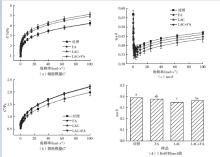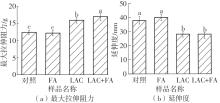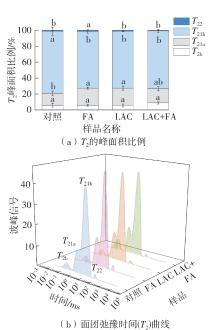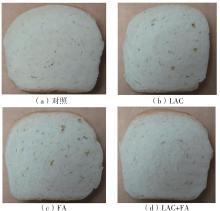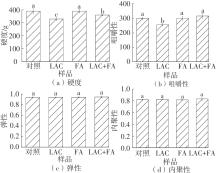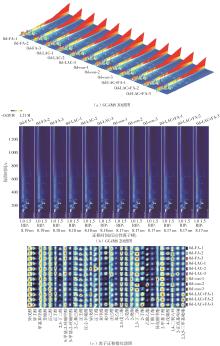Journal of South China University of Technology(Natural Science Edition) ›› 2025, Vol. 53 ›› Issue (4): 113-124.doi: 10.12141/j.issn.1000-565X.240221
• Food Science & Technology • Previous Articles Next Articles
Effect of Laccase Synergy with Ferulic Acid on the Rheological Properties of Wheat Dough and the Quality of Bread
LI Bing1, HE Min1, HE Ni1, PAN Zhiqin1, ZHANG Xia1, CHEN Xinran1, LI Junyi3, LI Lin1,2
- 1.School of Food Science and Engineering/Guangdong Province Key Laboratory for Green Processing of Natural Products and Product Safety,South China University of Technology,Guangzhou 510640,Guangdong,China
2.School of Chemical Engineering and Energy Technology,Dongguan University of Technology,Dongguan 523808,Guangdong,China
3.Faculty of Science and Technology,Beijing Normal University-Hong Kong Baptist University United International College,Zhuhai 519000,Guangdong,China
-
Received:2024-05-07Online:2025-04-25Published:2024-07-05 -
About author:李冰(1972—),女,博士,教授,主要从事食品与生物化工研究。E-mail: bli@scut.edu.cn -
Supported by:the Key-Area Research and Development Program of Guangdong Province(2020B020226007)
CLC Number:
Cite this article
LI Bing, HE Min, HE Ni, PAN Zhiqin, ZHANG Xia, CHEN Xinran, LI Junyi, LI Lin. Effect of Laccase Synergy with Ferulic Acid on the Rheological Properties of Wheat Dough and the Quality of Bread[J]. Journal of South China University of Technology(Natural Science Edition), 2025, 53(4): 113-124.
share this article
Table 2
Effects of LAC and FA on the color parameters of bread crumbs"
样品 名称 | ΔE | L* | a* | b* |
|---|---|---|---|---|
| 对照 | 71.28 ± 0.81a | 66.65 ± 1.58a | 4.80 ± 1.72a | 24.66 ± 2.16a |
| FA | 71.67 ± 1.96a | 67.81 ± 1.60ab | 3.36 ± 0.83a | 22.92 ± 1.03a |
| LAC | 73.87 ± 1.35a | 69.58 ± 1.59ab | 3.92 ± 0.15a | 24.46 ± 0.31a |
| LAC+FA | 74.10 ± 1.46a | 70.14 ± 1.61b | 3.297 ± 0.64a | 23.66 ± 1.52a |
Table 3
Volatile compounds identified in wheat breads"
| 序号 | 化合物名称 | CAS号 | 分子式 | 相对分子质量 | 保留指数 | 保留时间/s | 相对迁移时间 |
|---|---|---|---|---|---|---|---|
| 1 | 异戊醇 | C123513 | C5H12O | 88.10 | 735.900 | 231.101 | 1.499 3 |
| 2 | 异丁醇 | C78831 | C4H10O | 74.10 | 630.700 | 158.049 | 1.383 7 |
| 3 | 甲基苯甲醇 | C98851 | C8H10O | 122.20 | 1 058.100 | 731.887 | 1.189 6 |
| 4 | 芳樟醇 | C78706 | C10H18O | 154.25 | 1 092.000 | 788.223 | 1.223 1 |
| 5 | 正己醇 | C111273 | C6H14O | 102.20 | 866.800 | 373.659 | 1.648 7 |
| 6 | 正丁醇 | C71363 | C4H10O | 74.10 | 677.200 | 183.490 | 1.179 7 |
| 7 | 2,3-丁二醇 | C513859 | C4H10O2 | 90.10 | 789.400 | 284.701 | 1.370 5 |
| 8 | 5-甲基-2-呋喃甲醇 | C3857258 | C6H8O2 | 112.10 | 955.200 | 533.381 | 1.263 1 |
| 9 | 5-甲基-2-呋喃甲醇 | C3857258 | C6H8O2 | 112.10 | 952.800 | 528.390 | 1.565 8 |
| 10 | 2-乙基己醇 | C104767 | C8H18O | 130.20 | 1 006.400 | 638.904 | 1.793 8 |
| 11 | 正壬醛 | C124196 | C9H18O | 142.20 | 1 108.400 | 815.119 | 1.490 6 |
| 12 | 反-2-辛烯醛 | C2548870 | C8H14O | 126.20 | 1 056.800 | 729.695 | 1.327 5 |
| 13 | 异戊醛 | C590863 | C5H10O | 86.10 | 649.600 | 167.434 | 1.195 4 |
| 14 | 正丁醛 | C123728 | C4H8O | 72.10 | 604.600 | 146.351 | 1.286 2 |
| 15 | 苯甲醛 | C100527 | C7H6O | 106.10 | 952.900 | 528.630 | 1.150 0 |
| 16 | 苯甲醛 | C100527 | C7H6O | 106.10 | 953.300 | 529.476 | 1.460 3 |
| 17 | 正己醛 | C66251 | C6H12O | 100.20 | 787.500 | 282.780 | 1.554 4 |
| 18 | 苯乙醛 | C122781 | C8H8O | 120.20 | 1 038.400 | 697.949 | 1.261 1 |
| 19 | 2,3-戊二酮 | C600146 | C5H8O2 | 100.10 | 163.258 | 636.300 | 1.216 7 |
| 20 | 2-戊酮 | C107879 | C5H10O | 86.10 | 694.200 | 195.328 | 1.131 0 |
| 21 | 2-庚酮 | C110430 | C7H14O | 114.20 | 892.400 | 412.174 | 1.263 6 |
| 22 | 2,3-丁二酮 | C431038 | C4H6O2 | 86.10 | 592.200 | 141.069 | 1.172 0 |
| 23 | 2-丁酮 | C78933 | C4H8O | 72.10 | 589.800 | 140.018 | 1.241 3 |
| 24 | 乙酸乙酯 | C141786 | C4H8O2 | 88.10 | 616.700 | 151.644 | 1.333 6 |
| 25 | 丁酸丁酯 | C109217 | C8H16O2 | 144.20 | 1 003.500 | 633.237 | 1.342 6 |
| 26 | 异戊酸甲酯 | C556241 | C6H12O2 | 116.20 | 793.100 | 288.528 | 1.211 8 |
| 27 | 2-甲基丁酸 | C116530 | C5H10O2 | 102.10 | 867.300 | 374.272 | 1.480 9 |
| 28 | 4-戊烯酸 | C591800 | C5H8O2 | 100.10 | 897.700 | 421.103 | 1.438 6 |
| 29 | 1,4-二氧六环 | C123911 | C4H8O2 | 88.10 | 710.000 | 207.870 | 1.328 8 |
| 30 | 2-正戊基呋喃 | C3777693 | C9H14O | 138.20 | 993.900 | 614.134 | 1.249 0 |
| 31 | 2,3,5-三甲基吡嗪 | C14667551 | C7H10N2 | 122.20 | 987.600 | 601.313 | 1.169 1 |
| 1 | MINUSSI R C, PASTORE G M, DURÁN N .Potential applications of laccase in the food industry[J].Trends in Food Science & Technology,2002,13(6/7):205-216. |
| 2 | GUAN Z, LUO Q, WANG H,et al .Bacterial laccases:promising biological green tools for industrial applications[J].Cellular and Molecular Life Sciences,2018,75(19):3569-3592. |
| 3 | 张海华,朱跃进,张士康,等 .茶多酚对高筋粉面团流变特性的影响[J].食品科学,2016,37(13): 42-46. |
| ZHANG Haihua, ZHU Yuejin, ZHANG Shikang,et al .Effect of tea polyphenols on rheological properties of high-gluten wheat dough[J].Food Science,2016,37(13):42-46. | |
| 4 | SI J Q .Use of laccase in baking:WO1994028728[P].1994-12-22. |
| 5 | MANHIVI V E, AMONSOU E O, KUDANGA T .Laccase-mediated crosslinking of gluten-free amadumbe flour improves rheological properties[J].Food Chemistry,2018,264:157-163. |
| 6 | MCKERCHAR H J, CLERENS S, DOBSON R C J,et al .Protein-protein crosslinking in food:proteomic characterisation methods,consequences and applications[J].Trends in Food Science & Technology,2019,86:217-229. |
| 7 | SELINHEIMO E, KRUUS K, BUCHERT J,et al .Effects of laccase,xylanase and their combination on the rheological properties of wheat doughs[J].Journal of Cereal Science,2006,43(2):152-159. |
| 8 | FLANDER L, ROUAU X, MOREL M,et al .Effects of laccase and xylanase on the chemical and rheological properties of oat and wheat doughs[J].Journal of Agricultural and Food Chemistry,2008,56(14):5732-5742. |
| 9 | PRIMO-MARTIN C, VALERA R, MARTINEZ-ANAYA M A .Effect of pentosanase and oxidases on the characteristics of doughs and the glutenin macropolymer (GMP)[J].Journal of Agricultural and Food Chemistry,2003,51(16):4673-4679. |
| 10 | MATTINEN M L, KRUUS K, BUCHERT J,et al .Laccase-catalyzed polymerization of tyrosine-containing peptides[J].FEBS Journal,2005,272(14):3640-3650. |
| 11 | LANTTO R, SCHÖNBERG C, BUCHERT J,et al .Effects of laccase-mediator combinations on wool[J].Textile Research Journal,2004,74(8):713-717. |
| 12 | DENG N, BIAN X, LUO S,et al .The starch-polyphenol inclusion complex:preparation,characterization and digestion[J].Food Bioscience,2023,53:102655/1-8. |
| 13 | WU N, LI H, TAN B,et al .Free and bound phenolic profiles of the bran from different rice varieties and their antioxidant activity and inhibitory effects on ɑ-amylose and ɑ-glucosidase[J].Journal of Cereal Science,2018,82:206-212. |
| 14 | SCHEFER S, OEST M, ROHN S .Interactions between phenolic acids,proteins,and carbohydrates-influence on dough and bread properties[J].Foods,2021,10(11):2798/1-29. |
| 15 | LABAT E, MOREL M H, ROUAU X .Effects of laccase and ferulic acid on wheat flour doughs[J].Cereal Chemistry,2000,77(6):823-828. |
| 16 | FæRGEMAND M, OTTE J, QVIST K B. Cross-linking of whey proteins by enzymatic oxidation[J].Journal of Agricultural and Food Chemistry,1998,46(4):1326-1333. |
| 17 | MIGLIORI M, GABRIELE D .Effect of pentosan addition on dough rheological properties[J].Food Research International,2010,43(9):2315-2320. |
| 18 | 夏明威 .复合改良剂对冷冻全麦面团及其烘焙面包品质的影响[D].广州:华南理工大学,2022. |
| 19 | 任顺成,陈玉,陶华 .玉米醇溶蛋白和南瓜子蛋白对面团特性与面制品品质的影响[J].河南工业大学学报(自然科学版),2022,43(2):33-39. |
| REN Shuncheng, CHEN Yu, TAO Hua .Effects of zein and pumkin seed protein on dough properties and flour products qualities[J].Journal of Henan University of Technology(Natural Science Edition),2022,43(2): 33-39. | |
| 20 | 张艳,王彦飞,陈新民,等 .Mixolab参数与粉质、拉伸参数及面包烘烤品质的关系[J].作物学报,2009,35(9):1738-1743. |
| ZHANG Yan, WANG Yanfei, CHEN Xinmin,et al .Relationships of Mixolab parameters with farinograph,extensograph parameters,and bread-making quality[J].Acta Agronomica Sinica,2009,35(9):1738-1743. | |
| 21 | HAN H M, KOH B K .Effect of phenolic acids on the rheological properties and proteins of hard wheat flour dough and bread[J].Journal of the Science of Food and Agriculture,2011,91(13):2495-2499. |
| 22 | BUENO M M, SILVEIRA THYS R C, RODRIGUES R C .Microbial enzymes as substitutes of chemical additives in baking wheat flour-part I:individual effects of nine enzymes on flour dough rheology[J].Food and Bioprocess Technology,2016,9(12):2012-2023. |
| 23 | JIAO W, LI L, FAN P,et al .Effect of xanthan gum on the freeze-thaw stability of wheat gluten[J].Food Biophysics,2019,14(2):142-153. |
| 24 | FIGUEROA-ESPINOZA M C, MOREL M H, ROUAU X .Effect of lysine,tyrosine,cysteine,and glutathione on the oxidative cross-linking of feruloylated arabinoxylans by a fungal laccase[J].Journal of Agricultural and Food Chemistry,1998,46(7):2583-2589. |
| 25 | KIEFFER R, WIESER H, HENDERSON M H,et al .Correlations of the breadmaking performance of wheat flour with rheological measurements on a micro-scale[J].Journal of Cereal Science,1998,27(1):53-60. |
| 26 | WANG M W, van VLIET T, HAMER R J .How gluten properties are affected by pentosans[J].Journal of Cereal Science,2004,39(3):395-402. |
| 27 | YI J, KERR W L .Combined effects of freezing rate,storage temperature and time on bread dough and baking properties[J].LWT-Food Science and Technology,2009,42(9):1474-1483. |
| 28 | KOH B, NG P K W .Effects of ferulic acid and transglutaminase on hard wheat flour dough and bread[J].Cereal Chemistry,2009,86(1):18-22. |
| 29 | ZHAO X, HAN G, SUN Q,et al .Influence of lard-based diacylglycerol on the rheological and physicochemical properties of thermally induced pork myofibrillar protein gels at different pH levels[J].LWT-Food Science and Technology,2020,117:108708/1-9. |
| 30 | JIANG Y, ZHAO Y, ZHU Y,et al .Effect of dietary fiber-rich fractions on texture,thermal,water distribution,and gluten properties of frozen dough during storage[J].Food Chemistry,2019,297:124902/1-10. |
| 31 | YANG Y, GUAN E, ZHANG T,et al .Influence of water addition methods on water mobility characterization and rheological properties of wheat flour dough[J].Journal of Cereal Science,2019,89:102791/1-10. |
| 32 | PENG B, LI Y, DING S,et al .Characterization of textural,rheological,thermal,microstructural,and water mobility in wheat flour dough and bread affected by trehalose[J].Food Chemistry,2017,233:369-377. |
| 33 | ZHU Q, HAN K, WANG S,et al .Design and structural characterization of edible double network gels based on wheat bran arabinoxylan and pea protein isolate[J].International Journal of Biological Macromolecules,2022,213:824-833. |
| 34 | CABALLERO P A, GOMEZ M, ROSELL C M .Improvement of dough rheology,bread quality and bread shelf-life by enzymes combination[J].Journal of Food Engineering,2007,81(1):42-53. |
| 35 | NIÑO-MEDINA G, GUTIÉRREZ-SOTO G, URÍAS-ORONA V,et al .Effect of laccase from Trametes maxima CU1 on physicochemical quality of bread[J].Cogent Food & Agriculture,2017,3(1):1328762/1-7. |
| 36 | SELINHEIMO E, AUTIO K, KRIJUS K,et al .Elucidating the mechanism of laccase and tyrosinase in wheat bread making[J].Journal of Agricultural and Food Chemistry,2007,55(15):6357-6365. |
| 37 | ZHAO G, WEI L, LIU Y,et al .Impact of the fermentation broth of Ganoderma lucidum on the quality of Chinese steamed bread[J].AMB Express,2019,9:133/1-11. |
| 38 | SERVENTI L, SKIBSTED L H, KIDMOSE U .Individual and combined effects of water addition with xylanases and laccase on the loaf quality of composite wheat-cassava bread[J].European Food Research and Technology,2016,242(10):1663-1672. |
| 39 | JIANG D, CHIARO C, MADDALI P,et al .Identification of hydroxycinnamic acid-Maillard reaction pro-ducts in low-moisture baking model systems[J].Journal of Agricultural and Food Chemistry,2009,57(21):9932-9943. |
| 40 | ADELAKUN O E, KUDANGA T, PARKER A,et al .Laccase-catalyzed dimerization of ferulic acid amplifies antioxidant activity[J].Journal of Molecular Catalysis B-Enzymatic,2012,74(1/2):29-35. |
| 41 | ALJAWISH A, CHEVALOT I, JASNIEWSKI J,et al .Laccase-catalysed oxidation of ferulic acid and ethyl ferulate in aqueous medium:a green procedure for the synthesis of new compounds[J].Food Chemistry,2014,145:1046-1054. |
| 42 | PICO J, BERNAL J, GOMEZ M .Wheat bread aroma compounds in crumb and crust:a review[J].Food Research International,2015,75:200-215. |
| 43 | MILDNER-SZKUDLARZ S, RÓŻAŃSKA M, PIECHOWSKA P,et al .Effects of polyphenols on volatile profile and acrylamide formation in a model wheat bread system[J].Food Chemistry,2019,297:125008/1-10. |
| [1] | FU Yuming, LI Changcheng, YAN Maorong, et al. Microstructure and High Temperature Deformation Resistance of Nickel-Based Coating on TC4 Surface [J]. Journal of South China University of Technology(Natural Science Edition), 2025, 53(1): 108-117. |
| [2] | LUO Zhen, SU Jie, WANG Xiaohua, et al. Research Progress Analysis of Laser-Arc Hybrid Welding of Aluminum Alloys [J]. Journal of South China University of Technology(Natural Science Edition), 2024, 52(3): 57-74. |
| [3] | ZHANG Heng, HUANG Junguang, LI Weike, et al. Influence of Electroosmosis-Calcium Chloride Treatment on the Deformation of Sodium Sulfate Saline Soil [J]. Journal of South China University of Technology(Natural Science Edition), 2023, 51(4): 53-60. |
| [4] | YU Qijun, MA Ting, ZHANG Tongsheng, et al.. Effect of Particle Size on Hydration Kinetics and Microstructure Development of Recycled Brick Powder-Cement Pastes [J]. Journal of South China University of Technology(Natural Science Edition), 2023, 51(11): 63-73. |
| [5] | YIN Suhong, LI Yanmei, DING Weimin, et al.. Effect of Pyrite Tailings Mineralizer on Calcination and Properties of Cement Clinker [J]. Journal of South China University of Technology(Natural Science Edition), 2023, 51(11): 74-81. |
| [6] | TAN Haibing, LI Shu, WANG Jing, et al. Influence of Solution Temperature on Microstructure and Mechanical Property of GH4099 Alloy [J]. Journal of South China University of Technology(Natural Science Edition), 2022, 50(8): 136-143. |
| [7] | ZHENG Bisheng, YANG Wenhan, XU Qiuxiong, et al. Antitumor Activity of Ferulic Acid and Its Colonic Metabolites [J]. Journal of South China University of Technology(Natural Science Edition), 2022, 50(8): 30-40. |
| [8] | LIAO Yanfen, QIU Mengze, CHEN Shunkai, et al . Experimental Study on Thermal Drying Characteristics and Pollutant Discharge Law of Municipal Sludge [J]. Journal of South China University of Technology(Natural Science Edition), 2022, 50(8): 92-101. |
| [9] | CHEN Weiping, LI Bing, LING Zicheng, et al. Influence of Ce Addition on Microstructure and Corrosion Resistance to Molten Aluminum of Fe-Cr-B Alloys [J]. Journal of South China University of Technology (Natural Science Edition), 2021, 49(9): 73-79. |
| [10] | WEI Xiaolan, LIN Guoqing, DING Jing, et al. Simulation and Experiment Investigation into Specific Heat Capacity Enhancement of Nitrate Molten Salt Nanofluid [J]. Journal of South China University of Technology (Natural Science Edition), 2021, 49(9): 46-55. |
| [11] | ZHOU Tao, HE Lin, TIAN Pengfei, et al. Prediction Model of Microstructure Evolution in Shear Zone During Cutting Process [J]. Journal of South China University of Technology (Natural Science Edition), 2021, 49(1): 82-92. |
| [12] | XU Daofen, CHEN Kanghua, XING Jun, et al. Microstructure and Corrosion Behavior of 2219 Aluminum Alloy Forging's Joint by TIG Welding [J]. Journal of South China University of Technology(Natural Science Edition), 2020, 48(3): 116-125. |
| [13] |
YIN Xiaolong DENG Wenjun ZHANG Jiayang PI Yunyun .
Microstructure and Mechanical Properties of Al 7075 Alloy Prepared by Cryogenic-Temperature Extrusion Machining
|
| [14] | ZHANG Heng MA Qinguo HU He NIU Fujun. Experimental Research on the Effect of Using Calcium Chloride and Electroosmosis to Reinforce Silt Clay [J]. Journal of South China University of Technology (Natural Science Edition), 2019, 47(3): 119-125. |
| [15] | ZHOU Zhaoyao LUO Jiehan ZOU Chunhua ZOU Chunya. Microstructure and Property of Capacitor-Discharging Projection Welding Joints of T-Type Galvanized Nuts to Hot-Stamping Steels [J]. Journal of South China University of Technology(Natural Science Edition), 2018, 46(10): 81-87. |
| Viewed | ||||||
|
Full text |
|
|||||
|
Abstract |
|
|||||
